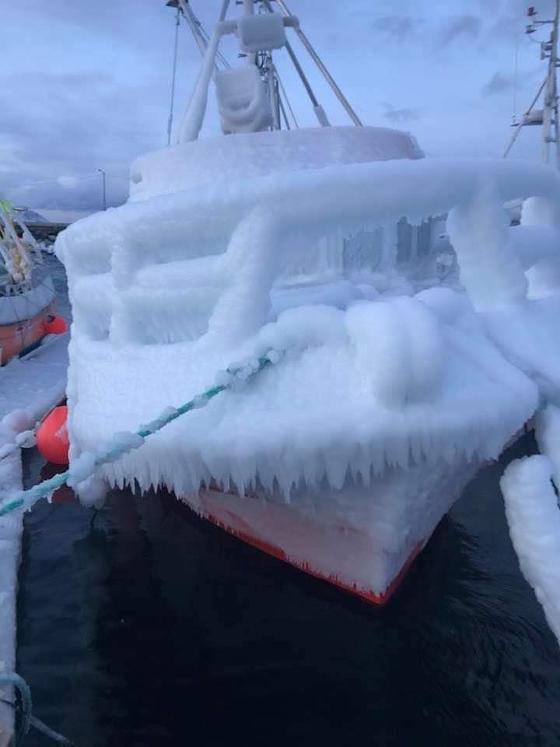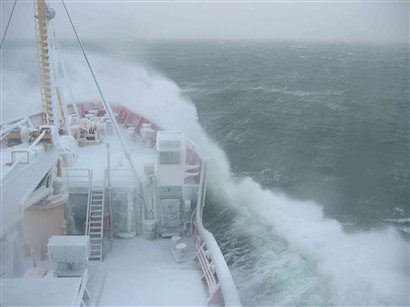About This Project
Project goal and objectives
This multi-faceted, multi-disciplinary research project offers a novel approach to furthering the current knowledge regarding spray icing, helping to develop a holistic perspective to understanding and meeting spray icing-concerned stakeholder needs. In particular, his project aims to achieve the following objectives:
- Refine the newly developed and operationally-applied spray icing model known as the Marine Icing Model for the Norwegian Coast Guard (MINCOG) for applications to both vessel icing and fish farms
- Develop a probabilistic framework wherein state-of-the-art statistical tools are explored for long-term forecasting of multivariate coupled time series and studying spray icing climatology
- Perform decision analyses for spray-icing-concerned risks applicable across various maritime sectors
- Develop an interactive platform for crowdsourcing field observations and communicating spray icing risk assessments
- Develop a decision support system for short-term and long-term risk-informed decisions related to spray icing


Work Packages
Work Package 1 – Physical modelling: In Work Package 1 we refine the sea spray icing model MINCOG, which predominantly focuses on wave-ship interaction sea spray as the main water source for icing events. Various existing challenges in spray icing modelling including spray amount estimation, turbulent heat transfer between the atmosphere and the wetted surface, wind-induced sea spray in fjord areas, and the effects of atmospheric icing and snow showers on spray icing accumulation process and rate will be addressed in this work package. This work package also seeks to generate regional-based operational forecasts of spray icing on fish farms, which currently do not exist.
Work Package 2 – Data collection: Work Package 2 focuses on data collection in relation to one of the main challenges of the current forecast models: an accurate estimation of spray flux based on vessel speed and wave characteristics, since the main contributor to spray icing is wave-ship interaction sea spray. In this perspective, we will collect measurements of spray amounts, in order to make relevant empirical expressions. We also collect measurements related to other water sources, like rain, fog, and snow might also potentially lead to icing. Moreover, we take an initiative to explore the possibility of collecting information on spray amounts by invoking a citizen science project where vessels and fish farm operators can report some meteorological and oceanographic parameters via an interactive platform. Parameters that are not collected from observations may be utilized trough high resolution meteorological data sets (e.g., NORA3).
Work Package 3 – Long-term simulation: Work Package 3 develops a mathematical framework in order to predict and simulate the meteorological and oceanographic parameters and thus spray icing rates and frequencies, while accounting for their interdependence and long-term drift. The abilities of machine learning algorithms, such as long-short-term-memory (LSTM) networks, and Bayesian-statistics methods, such as Sequential Monte Carlo (SMC) methods are explored to achieve this goal. The simulation-based framework is suitable for scenario-based studies related to the risks associated with industrial applications in the Arctic Ocean. The decadal changes in meteorological and oceanographic parameters and the impact of global warming and the effects of sea-ice retreat and its impact on wave heights and thus on spray icing rates will also be captured in the proposed simulation framework.
Work package 4 – Decision analysis: Work Package 4 contributes to spray icing-rated decisions and challenges faced by spray icing-concerned stakeholders face, among other techniques, via in-depth interviews. These interviews will be analysed and used to generate a value matrix of various spray icing-related decisions and challenges. Threshold analysis will be conducted to understand and identify different decision thresholds for spray icing-concerned stakeholders, as well as what spatial, temporal, or situational factors impact these thresholds.
Work Package 5 – Output and interactive platform: Work Package 5 employs crowdsourced data collection techniques, as well as data management and analysis from previous projects at SINTEF such as FiskInfo, where data is reported and shared between fishermen, as well as the general public via BarentsWatch platform for visualisation and communication. The app could serve as a template or testing platform or this project’s data collection platform, in addition to be a potential user base for the information we produce.
Work Package 6 – Decision support system
Work Package 6 supports spray icing-concerned stakeholders to utilise data to enhance their spray icing-related risk-informed decision-making. Tabletop exercises will be conducted to simulate various spray icing scenarios, during which participants are able to use different spray icing-related information to make informed decisions.
Work Package 7 – Project management
This work package covers the project’s administration, communication, and dissemination. In addition, this work package ensures that the project is carried out as planned in terms of research quality, research ethics. Communicating and disseminating the project’s progress and results are other tasks covered in this work package. Project results will be published in peer-reviewed journals and will be presented in international conferences, in accordance with the open science policy of The Research Council of Norway.
Funding
This project is co-funded by the Research Council of Norway (12.961 million NOK) via MAROFF-2 programme from 2021 to 2025, Grant Number: 320843, and is run jointly by UiT The Arctic University of Norway as the project owner, SINTEF Nord AS, The Norwegian Meteorological Institute, The Norwegian Coastal Administration, Hermes AS, and Gratanglaks AS.
Hermes AS, The Norwegian Coastal Administration, and UiT The Arctic University of Norway also contribute to the project financially by allocating personnel and equipment to the project.
Reference Group
1) Masoud Naseri, UiT The Arctic University of Norway
2) Dina Abdel-Fattah, UiT The Arctic University of Norway
3) Kåre Edvardsen, UiT The Arctic University of Norway
4) Truls Bakkejord Ræder, SINTEF Nord AS
5) Eirik Mikal Samuelsen, The Norwegian Meteorological Institute
6) Jan Roger Lerbukt, Hermes AS
7) Kjell Are Berg-Hagen, tranberg AS
8) Per Arild Åland, DNVGL
9) Trond Hjort-Larsen, The Norwegian Coastal Administration
10) Monica Eide-Hermansen, Gratanglaks AS
11) Sigurd Henrik Teigen, Equinor
12) Eirik Schrøder-Bråtane, Equinor